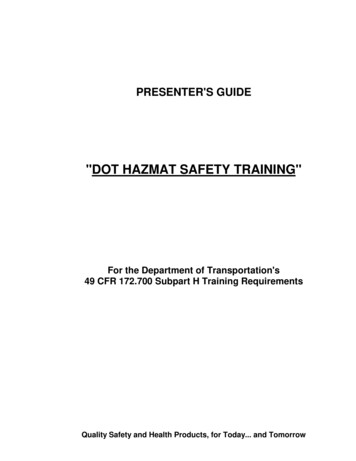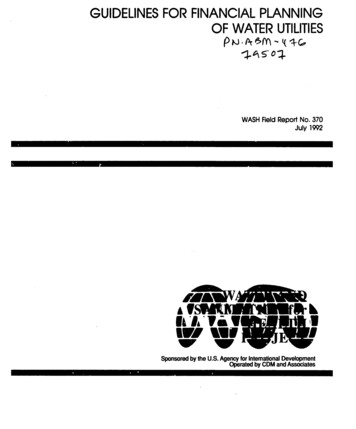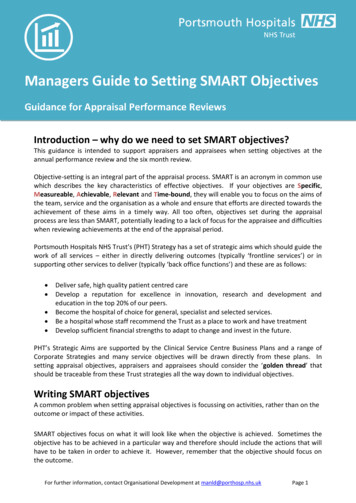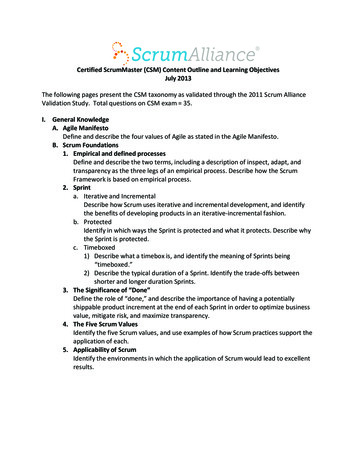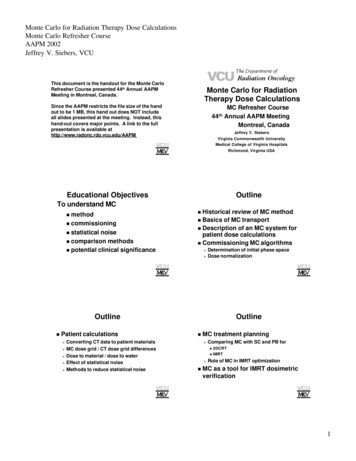
Transcription
Monte Carlo for Radiation Therapy Dose CalculationsMonte Carlo Refresher CourseAAPM 2002Jeffrey V. Siebers, VCUThis document is the handout for the Monte CarloRefresher Course presented 44th Annual AAPMMeeting in Montreal, Canada.Monte Carlo for RadiationTherapy Dose CalculationsSince the AAPM restricts the file size of the handout to be 1 MB, this hand out does NOT includeall slides presented at the meeting. Instead, thishand-out covers major points. A link to the fullpresentation is available athttp://www.radonc.rdo.vcu.edu/AAPMMC Refresher Course44th Annual AAPM MeetingMontreal, CanadaJeffrey V. SiebersVirginia Commonwealth UniversityMedical College of Virginia HospitalsRichmond, Virginia USAEducational ObjectivesOutlineTo understand MCmethodn commissioningn statistical noisen comparison methodsn potential clinical significancenHistorical review of MC methodn Basics of MC transportn Description of an MC system forpatient dose calculationsn Commissioning MC algorithmsnØØDetermination of initial phase spaceDose normalizationOutlinenPatient calculationsØØØØØConverting CT data to patient materialsMC dose grid / CT dose grid differencesDose to material / dose to waterEffect of statistical noiseMethods to reduce statistical noiseOutlinenMC treatment planningØComparing MC with SC and PB fornnØn3DCRTIMRTRole of MC in IMRT optimizationMC as a tool for IMRT dosimetricverification1
Monte Carlo for Radiation Therapy Dose CalculationsMonte Carlo Refresher CourseAAPM 2002Jeffrey V. Siebers, VCUHistorical Review ofMonte CarloHistorical ReviewCompiler DevelopmentEarly Beginnings1772: Compte de BuffonnØUses random sampling to solve mathematicalproblemnØ1945: ENIACnØFirst large scale electronic computer (JohnMauchly)1945: Stan Ulam, John van Neumann,Nicholas MetropolisnØØ1954-1957: FortranØnIBM (John Backus)First successful high level language1961: Fortran IVØStandardized FortranPropose using “computers” to solve neutrondiffusion problemsCoined name “Monte Carlo” (Metropolis)Historical ReviewHistorical ReviewEarly “general purpose” codesn1963: MCSØn1964: ETRAN (Martin Berger)n1962: O5RØØnnPrecursor to MCNP, general purpose MC codeØØØCondensed history approachPredecessor of NTC, NMTC, HETC, LAHET,MCNP-X intranuclear cascade codes1974: EGS1 (Ford and Nelson)EGS3 being used for Med Physicsn1983: Petti, contaminant electron studies1984: Rogers & Bielajew1985: Mohan, energy spectra1985: EGS4ØØ1986: Rogers and Bielajew publish first MedPhys papers on EGS4 (Med Phys, 13 5)256 References in PubMed for EGS4 (6/02)Historical Reviewn1993: Peregrine Project formed at LLNLn1995: BEAM and DOSXYZØØØnWhat is Monte Carlo?BEAM: Rogers et al, Med. Phys. 22 5DOSXYZ: Ma et al PIRS-0509b, NRCC, 1995Other Therapy Specific MC codesØØnRadiation Therapy Specific MC code1996: VMC/XVMC/VMC (Kawrakow et al)2000: DPM (Sempau et al)795 “hits” in PubMed with Monte Carlo radiation therapy2
Monte Carlo for Radiation Therapy Dose CalculationsMonte Carlo Refresher CourseAAPM 2002Jeffrey V. Siebers, VCUWhat is Monte Carlo?What is Monte Carlo?Simple ExampleSimple ExampleØGiven, photon of Energy E incident oninfinite (water) phantomnnDetermine interaction probabilitiesDetermine which interaction occurredby selecting another random number(RN’) total PhotoEffectPhotoEffect Compton PairnSelect Random Number (RN (0,1]) to chooseinteraction distanceØPhoto Effect occurs ifØCompton Effect occurs otherwiseRN ' PhotoEffect totalnx ln ( RN ) total (cm)Determine interaction products bysampling further distributionsØEnergy and angle (direction) of scatteredphoton / electronWhat is Monte Carlo?Monte Carlo MethodSimple ExamplenScore quantities of interestØØnnEnergy Deposition (Dose)FluenceFollow particles (and secondaries )until they are no longer of interestnParticle escapes geometryParticle is absorbedParticle drops below energy cut-offnØØØFollows the path of individualrepresentative particles throughaccelerator, beam modifiers, and patientto determine dose, fluence, and otherdistributions in patients and phantomsUses basic physics interactionprobabilities (sampled via selection ofrandom numbers) to determine the fate ofthe representative particlesSufficient representative particles aretransported to produce a statisticallyacceptable results (averages)Monte CarloMonte Carlo MethodItems of InterestThe particles transported only representreal particlesn Only 100 Million particles will be used ina patient simulationn During a 2 Gy fraction 1016 electrons incident upon the target, 1014 photons impinging on the patientn Increasing number of particlestransported increases computer time(linearly) but only improves statistics bythe square root of the number of particlesTarget tteningFilterIon ihilatione ePaire-PatientEPID3
Monte Carlo for Radiation Therapy Dose CalculationsMonte Carlo Refresher CourseAAPM 2002Jeffrey V. Siebers, VCUMC Program FlowWhy bother with MonteCarlo?Sample nextsource particleYesStack emptyTerminate historyPut particle on top oflast-in first-out stackNonCurrent algorithms are accurateenoughnClinical experience is with currentinaccurate algorithmsnMonte Carlo takes too longSelect particle fromtop of stackNoEnergy cutoff &particle in geometryYesElectronElectron or photon?Process electrontransport (creates 2nd aries)PhotonProcess photontransport (creates 2nd aries)Record events of interest(energy deposition, fluence )Why Monte Carlo?nRadiation transport is a complexprocessØØWhy Monte Carlo?nAccuracy of currently available dosecomputation models for planning ofradiation treatments is limitednDiscrepancies compared to true dosedistributions may be clinically significantfor many casesElectron interactions result innPhotons (Bremsstrahlung characteristic x-rays)nDelta-rays (knock on electrons)Photon interactions result innPhotons (Compton, Pair Production )nSecondary electrons (Compton, Photoelectrons)Current methods might have errors!Why Monte Carlo?Why Monte Carlo?nThe discrepancies revealed by accuratepredictions of dose can be remedied usingdifferent treatment techniques, e.g., use ofdifferent margins, beam energies, beamarrangements, and intensity modulationnnnnHigh accuracy is now practical andaffordable with Monte Carlo simulations ofradiation transportWe can do something about it!nUniversal accuracy: all materials,modalities, anatomic geometries, devices, .Can simulate ACTUAL beam delivery(moving MLC’s , dynamic wedges, etc).Elimination of laborious trial and errorparameterization and refinement of modelsReduction in time and the amount ofmeasured dose distribution data requiredfor commissioning and validationIt might even be easier!4
Monte Carlo for Radiation Therapy Dose CalculationsMonte Carlo Refresher CourseAAPM 2002Jeffrey V. Siebers, VCUWhy Monte Carlo?nnnnDirect prediction of monitor units reducingthe probability of human mistakesImprovement in consistency of interinstitutional resultsImprovement in quality of dose responsedataAccurate estimation of quantities difficultor impossible to measureHow do we do Monte Carlodose calculations?Accurate dose has benefits!TargetCollimatorVacuum WinFlattening FilterIon ChamberPSD PlaneStage 1: PSD GenerationTransport particles to IC exitStage 1: Creation of InitialPhase SpaceJawsMLCStage 2: Patient CalculationsTransport particles throughpatient dependent devices.(jaws, blocks, mlc, wedges,and patient/phantom)BlocksWedgesPatient / PhantomnMethodnSensitivity to incidentelectron beam parametersnVerification and validationInitial Phase Space(Ψ(E,x,y,u,v) )Input Accelerator GeometryMCNP Geometry plotted with SabrinaBEAM Geometry plotted with EGS-WindowsnAssumeØØØnnElectron beam is radially symmetric and GaussianGeometry specification is correct Iterate adjusting E, s E, s R to matchprofiles and depth doseRecent papers on this ØØD. Sheikh-Bagheri and D. W. Rogers, “Sensitivity of megavoltage photon beamMonte Carlo simulations to electron beam and other parameters,” Med Phys 29(3), 379 -90 (2002).G. X. Ding, “Energy spectra, angular spread, fluence profiles an d dosedistributions of 6 and 18 MV photon beams: results of Monte Carl o simulationsfor a Varian 2100EX accelerator,” Phys Med Biol 47, 1025-46 (2002).5
Monte Carlo for Radiation Therapy Dose CalculationsMonte Carlo Refresher CourseAAPM 2002Jeffrey V. Siebers, VCUInitial Phase SpaceInitial Phase SpaceDependence of Depth Dose on EnergyDependence of lateral profile on energy1.81.21.81.0MeasurementMonte Carlo E 17.0 MeVMonte Carlo E 19.0 MeV1.60.80.40.201020Depth (cm)30Relative dose1.40.61.001.020.98MeasurementMonte Carlo E 5.6 MeVMonte Carlo E 6.4 MeV1.21.00.964050.810X (cm)Relative doseRelative dose1.4Relative dose1.02MeasurementMonte Carlo E 5.6 MeVMonte Carlo E 6.4 MeV1.61.00150.98MeasurementMonte Carlo E 17.0 MeVMonte Carlo E 19.0 MeV0.60.40.960.20102030405Monte Carlo dose perparticle to dose per MU1015X (cm)Depth (cm)TargetCollimatorVacuum WinFlattening FilterIon ChamberPSD PlaneSave Initial PhaseSpace for Future UseJawsnnNormalize to a pointorIntegrate measured and MC 10 10 inphantom depth dose curves between5 and 15 cmnØBlocksWedgesK 5 Dmeasured ( z) dz 5 Dcomputed ( z )dzDose Fluence MU Dose MU Fluence 15n15nSingle MU calibration factor used forall fieldsnnnnnA. E. Schach von Wittenau, L. J. Cox, P. M. Bergstrom, Jr., W. P. Chandler, C. L.Hartmann Siantar, and R. Mohan, “Correlated histogram representation of MonteCarlo derived medical accelerator photon- output phase space,” Med Phys 2 6 (7),1196-211 (1999)J. V. Siebers, P. J. Keall, B. Libby, and R. Mohan, “Comparison of EGS4 andMCNP4b Monte Carlo codes for generation of photon phase space distributionsfor a Varian 2100C,” Phys Med Biol 44 (12), 3009- 26 (1999)J. Deng, S. B. Jiang, A. Kapur, J. Li, T. Pawlicki, and C. M. Ma, “Photon beamcharacterization and modelling for Monte Carlo treatment planning,” Phys MedBiol 45 (2), 411- 27 (2000)I. Chetty, J. J. DeMarco, and T. D. Solberg, “A virtual source model for MonteCarlo modeling of arbitrary intensity distributions,” Med Phys 2 7 (1), 166-72(2000)M. K. Fix, H. Keller, P. Ruegsegger, and E. J. Born, “Simple beam models forMonte Carlo photon beam dose calculations in radiotherapy,” Med Phys 27 (12),2739-47 (2000)M. K. Fix, M. Stampanoni, P. Manser, E. J. Born, R. Mini, and P. Ruegsegger, “Amultiple source model for 6 MV photon beam dose calculations using MonteCarlo,” Phys Med Biol 4 6 (5), 1407 -27 (2001)Phase space particlesfrom BEAMsimulations ofupstream beam linePhase SpaceModelsPatient / PhantomCommissioning /Acceptance testingPhase Space ReferencesnPhase Space FilesMLCnnnSet acceptance criteria for dose profile(2%, 2mm) and output agreement (1%)Water phantom comparisonsØDepth Dose (open and wedged, various field sizes)ØLateral Profiles (open and wedged, various fieldsizes)Dose profile comparisons in specificmaterials / interfaces6
Monte Carlo for Radiation Therapy Dose CalculationsMonte Carlo Refresher CourseAAPM 2002Jeffrey V. Siebers, VCUCommissioning /Acceptance testingnStandard Tx planning tests (TG-53)ØØOrientation, device selection, Calculation verificationCT number to material conversionn Users will likely perform additionalconfidence building testsnDosimetricVerification ofa PSD(LLNLPeregrine)Dosimetric VerificationReferencesnnnnnnC. L. Hartmann Siantar, R. S. Walling, T. P. Daly, B. Faddegon, N. Albright, P.Bergstrom, A. F. Bielajew, C. Chuang, D. Garrett, R. K. House, D. Knapp, D. J.Wieczorek, and L. J. Verhey, “Description and dosimetric verification of thePEREGRINE Monte Carlo dose calculation system for photon beams incident ona water phantom,” 2 8 (7), 1322-37 (2001).C. M. Ma, E. Mok, A. Kapur, T. Pawlicki, D. Findley, S. Brain, K. Korster, and A.L. Boyer, “Clinical implementation of a Monte Carlo treatment pl anning system,”Med Phys 26 (10), 2133 -43 (1999)E. Spezi, D. G. Lewis, and C. W. Smith, “Monte Carlo simulation and dosimetricverification of radiotherapy beam modifiers,” Phys Med Biol 46 (11), 3007- 29(2001)L. Wang, M. Lovelock, and C. S. Chui, “Experimental verification of a CT -basedMonte Carlo dose-calculation method in heterogeneous phantoms,” Med Phys 2 6(12), 2626- 34 (1999)M. Fippel, W. Laub, B. Huber, and F. Nusslin, “Experimental investigation of afast Monte Carlo photon beam dose calculation algorithm,” Phys Me d Biol 44(12), 3039- 54 (1999)J. S. Li, T. Pawlicki, J. Deng, S. B. Jiang, E. Mok, and C. M. Ma, “Validation of aMonte Carlo dose calculation tool for radiotherapy treatment pla nning,” Phys MedBiol 45 (10), 2969- 85 (2000)CT to MaterialConversionnConversion of patient CT imagefor MC transportn The MC runn Effect of patient noisen Dose to water conversionn Plan comparisonsnctcreate blending of voxelsctcreate (BEAM distribution)ØØnStage 2: Patient Simulationuses mean CT number in dose grid voxel toassign density and materialuses dose grid voxels for particle transport52 materials in CT-to-densityconversionØØØcovers density from 0-2.0 g/cm2most materials from ICRU-46to minimize error in dose-to-materialconversion7
Monte Carlo for Radiation Therapy Dose CalculationsMonte Carlo Refresher CourseAAPM 2002Jeffrey V. Siebers, VCUPatient SimulationsVoxel BlendingAn example of MC integrationinto commercial TPSn Effect of MC Noisen Dose to ?n Plan ComparisonsnReduces resolutionn Homogenizes patientn May impact dose at interfacesnnNote: CT data itself ishomogenization Example MonteCarlo CodeImplementationØØØØØØMCV developed interface to NRCC EGS4BEAM / DOSXYZ codeBEAM used for transport through treatmenthead (Jaws, wedges, etc)Internal MC routines used for MLC and EPIDsimulationsDOSXYZ for patient / phantom simulationInterfaced to Pinnacle treatment planningsystemUnix workstations (multi -processor,multi computer)Breast Case Comparison4 fieldPinnacleMCVDose/FX (cGy)BreastDose Difference: MCV-PinnacleMCV-PinnacleEffect of Statistical NoisennEach dose point has statisticaluncertaintyEffect on plan evaluationØØØDose Difference (cGy)nnIsodoseDVHTCP / NTCP / EUDEffect on prescriptionMethods to reduce noise8
Monte Carlo for Radiation Therapy Dose CalculationsMonte Carlo Refresher CourseAAPM 2002Jeffrey V. Siebers, VCUEffect of Statistical NoisePatient PrescriptionsAs the number of points in a dose distribution increases,so does the maximum deviation from the meanConsequenceUnacceptable: Point Dose PrescriptionsnAcceptable level ( 2%)ØnRemoving from DVHØPrescribe 200 cGy per fraction to 90% of maximum doseAcceptable: Regional or Dose (MU) based prescriptionsPrescribe 200 cGy per fraction to 98% of the tumor volumeMethods to reduce statisticalnoisenP. J. Keall, J. V. Siebers, R. Jeraj, and R. Mohan, “The effect ofdose calculation uncertainty on the evaluation of radiotherapyplans,” Med Phys 27 (3), 478-84 (2000).ØJ. Sempau and A. F. Bielajew, “Towards the elimination of MonteCarlo statistical fluctuation from dose volume histograms forradiotherapy treatment planning,” Phys Med Biol 45 (1), 131-57(2000).S. B. Jiang, T. Pawlicki , and C. M. Ma, “Removing the effect ofstatistical uncertainty on dose-volume histograms from Monte Carlodose calculations,” Phys Med Biol 45 (8), 2151-61 (2000).Example of denoising Denoising / SmoothingØJ. O. Deasy, “Denoising of electron beam Monte Carlo dosedistributions using digital filtering techniques,” Phys Med Biol 45 (7),1765-79 (2000).ØWE-D-517D-2: Miao et al: “3-D Anisotropic Diffusion and WaveletFiltering of Monte Carlo Dose Distribution”WE-D-517D-4: Kawrakow: “Smoothing Monte Carlo CalculatedDose Distributions for Radiation Treatment Planning”ØExample of denoising Example of denoising 9
Monte Carlo for Radiation Therapy Dose CalculationsMonte Carlo Refresher CourseAAPM 2002Jeffrey V. Siebers, VCUExample of denoising DenoisingCan reduce MC dose calculationtime by factor of 8n Can introduce artifactsn Must be applied carefullyn(see papers and posters)How to compare with MC?Dose to water or dose towater?Absorbed Dose to WaterStatement of the problemnnnnnMeasurements are typically in terms of DwaterCurrent clinical experience in radiationtherapy is based upon Dwater“Conventional” algorithms compute DwaterMonte Carlo dose algorithms most accuratewhen they compute DmediumTo compare, need a method to convertDwater to Dmedium .Water-to-Material StoppingPower RatiosnMethod of conversionØnJ. V. Siebers, P. J. Keall, A. E. Nahum, and R. Mohan, “Converting absorbeddose to medium to absorbed dose to water for Monte Carlo-based photonbeam dose calculations,” Phys Med Biol 4 5 (4), 983- 95 (2000).AAPM Point / CounterpointØØH. H. Liu, “Dm rather than Dw should be used in Monte Carlo treatmentplanning. For the proposition,” Med Phys 2 9 (5), 922-3 (2002).Dm rather than Dw should be used in Monte Carlo treatment planning.Against the proposition,” Med Phys 29 (5), 923- 4 (2002)Patient Plan Comparisons10
Monte Carlo for Radiation Therapy Dose CalculationsMonte Carlo Refresher CourseAAPM 2002Jeffrey V. Siebers, VCUBreast CaseBreast CaseIsodose ComparisonDose Difference DisplayPinnacleDmaterialDwaterMCV - PinnacleMCV - PinnacleMCV 10 5 3 2 1-1-2-3-5-10BreastDose Difference: MCV-PinnacleDwaterLung CaseMCVMCV - PinnacleMCV - PinnacleMCV-PinnacleMCV - PinnacleDose Difference (%)Dose Difference (%)Relevant Papers for MCComparisonsHead and NeckCasenMCVMCV - PinnaclenPinnacleMCVnnP. Francescon, C. Cavedon, S. Reccanello, and S. Cora, “Photon dosecalculation of a three -dimensional treatment planning system compared to theMonte Carlo code BEAM,” Med Phys 27 (7), 1579- 87 (2000)C. M. Ma, E. Mok, A. Kapur, T. Pawlicki, D. Findley, S. Brain, K. Korster, and A.L. Boyer, “Clinical implementation of a Monte Carlo treatment pl anning system,”Med Phys 26 (10), 2133 -43 (1999)M. Miften, M. Wiesmeyer, A. Kapur, and C. M. Ma, “Comparison of RTP dosedistributions in heterogeneous phantoms with the BEAM Monte Carlo simulationsystem,” J Appl Clin Med Phys 2 (1), 21- 31 (2001)L. Wang, E. Yorke, G. Desobry, and C. S. Chui, “Dosimetric advantage of using 6MV over 15 MV photons in conformal therapy of lung cancer: MonteCarlostudies in patient geometries,” J Appl Clin Med Phys 3 (1), 51-9 (2002)Dose Difference (%)11
Monte Carlo for Radiation Therapy Dose CalculationsMonte Carlo Refresher CourseAAPM 2002Jeffrey V. Siebers, VCUHead and Neck CaseMonte Carlo and IMRTMCV - PinnaclennnnnImpact for IMRT?nnIMRTConsequences of inaccuracynConsequences ofinaccuracySystematic errorØØFor a given intensity distribution, dosepredicted differs from that actually deliveredto the patient/phantomCan be avoided by performing finalcalculation with accurate algorithmnConvergence errorØConsequence of systematic error during optimizationØOptimization with an inaccurate algorithm results indifferent intensities than those predicted by anaccurate algorithmØActual dose is not optimal, a better solution existsCan be avoided by optimization with an accuratealgorithmØIMRTComparison between Film and SCon Flat Phantom(a)(b)R. Jeraj and P. J. Keall, “The effect of statistical uncertainty on inverse treatmentplanning based on Monte Carlo dose calculation,” Phys Med Biol 4 5 (12), 3601-13.(2000)R. Jeraj, P. J. Keall, and J. V. Siebers, “The effect of dose calculation accuracy oninverse treatment planning,” Phys Med Biol 47 (3), 391-407 (2002)C. M. Ma, T. Pawlicki, S. B. Jiang, J. S. Li, J. Deng, E. Mok, A. Kapur, L. Xing, L. Ma,and A. L. Boyer, “Monte Carlo verification of IMRT dose distributions from acommercial treatment planning optimization system,” Phys Med Biol 45 (9), 2483- 95(2000)T. Pawlicki and C. M. Ma, “Monte Carlo simulation for MLC-based intensitymodulated radiotherapy,” Med Dosim 26 (2), 157- 68 (2001)W. U. Laub, A. Bakai, and F. Nusslin, “Intensity modulated irradiation of a thoraxphantom: comparisons between measurements, Monte Carlo calculations and pencilbeam calculations,” Phys Med Biol 4 6 (6), 1695- 706 (2001)W. Laub, M. Alber, M. Birkner, and F. Nusslin, “Monte Carlo dose computation forIMRT optimization,” Phys Med Biol 45 (7), 1741-54 (2000)J. V. Siebers, M. Lauterbach, S. Tong, Q. Wu, and R. Mohan, “Reducing dosecalculation time for accurate iterative IMRT planning,” Med Phys 29 (2), 231- 7 (2002)VCU IMRT Case(c)12
Monte Carlo for Radiation Therapy Dose CalculationsMonte Carlo Refresher CourseAAPM 2002Jeffrey V. Siebers, VCUIMRTComparison between Film and SCon Flat Phantom(a)(b)(c)Questions to ask your MCvendor / developer?nWhat is the acceptance criteria (systematic errors)?nHow fast is the Code (field size, voxel size, Tx volume)?What is the statistical uncertainty at that quoted speed?nnnHow much must I spend on computers?Does it compute D water so I can compare results withother algorithms and relate to my clinical experience?Points with a dose difference 2% or a DTA 2 mm are considered dosimetrically equivalent. For the MCcomputation, 97% of the points fall in that categorySummaryMC Historyn Basics of MCn Commissioning of MCn Patient Calculationsn MC and IMRTn13
Monte Carlo Refresher Course AAPM 2002 Jeffrey V. Siebers, VCU 1 This document is the handout for the Monte Carlo Refresher Course presented 44 th Annual AAPM Meeting in Montreal, Canada. Since the AAPM restricts the file size of the hand out to be 1 MB, this hand out does NOT include all slides presented at the meeting. Instead, this





